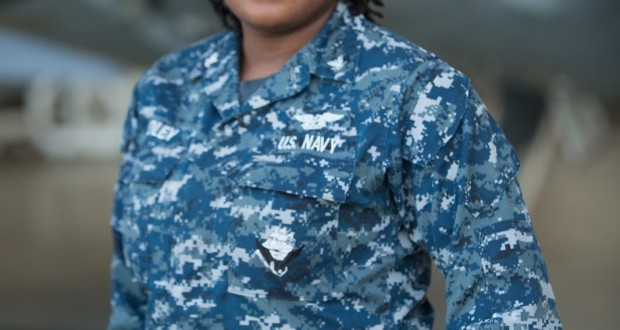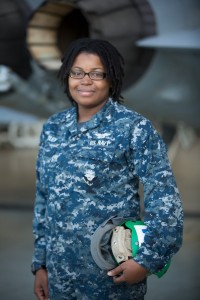By Chief Petty Officer Bill Steele, Navy Office of Community Outreach
A 2013 Pacific High School graduate and San Bernadino, California native is serving with a U.S. Navy strike fighter squadron that flies one of the Navy’s newest and most technologically-advanced aircraft, the F/A-18 E/F Super Hornet.
Petty Officer 3rd Class Danyielle Ridley is an aviation structural mechanic with the “Flying Eagles” of Strike Fighter Squadron (VFA) 122 “Super Hornets”, stationed in Lemoore, California. The squadron is currently training at Naval Air Station Whidbey Island, Washington.
As an aviation structural mechanic, Ridley is responsible for repairing the structure the jet aircraft and changing the hydraulic components.
“I enjoy anything with hydraulics,” said Ridley. “I think it’s interesting how it works. I never knew anything about hydraulics until I joined the Navy.”
The F/A-18 Hornet, an all-weather aircraft, is used as an attack aircraft as well as a fighter. In its fighter mode, it is used primarily as a fighter escort and for fleet air defense; in its attack mode, it is used for force projection, interdiction and close and deep air support, according to Navy sources.
The newest model, Super Hornet, is highly capable across the full mission spectrum: air superiority, fighter escort, reconnaissance, aerial refueling, close air support, air defense suppression and day or night precision strike. Compared to the original aircraft, according to Navy officials, Super Hornet has longer range, an aerial refueling capability, increased survivability and improved carrier suitability.
“I like that this is a training command—it gives us lots of room to learn,” said Ridley.
As a member of one of the Navy’s squadrons with the newest aircraft platforms, Ridley and other VFA-122 sailors are proud to be part of a warfighting team that readily defends America at all times.
Sailors’ jobs are highly varied at VFA-122, according to Navy officials. Since the squadron is the 10th largest in the world, with over 100 aircraft operating, sailors must make up and keep all parts of the squadron running smoothly — this includes everything from maintaining airframes and engines, to processing paperwork, handling weaponry, and flying the aircraft.
Serving in the Navy, Ridley is learning about being a more responsible leader, sailor and citizen through handling numerous responsibilities.
“I first joined the Navy just to get education, but something about it makes me want to do it forever,” Ridley added. “It’s never boring at work, it’s not repetitive. Jets are exciting.”
 Westside Story Newspaper – Online The News of The Empire – Sharing the Quest for Excellence
Westside Story Newspaper – Online The News of The Empire – Sharing the Quest for Excellence





